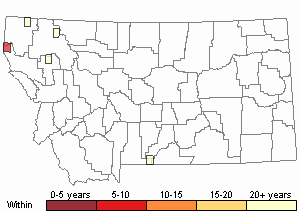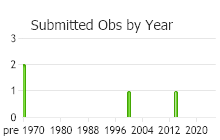View in other NatureServe Network Field Guides
NatureServe
Montana
Utah
Wyoming
Idaho
Wisconsin
British Columbia
South Carolina
Yukon
California
New York
A Homalothecium Moss - Homalothecium fulgescens
Other Names:
Homalothecium lutescens
General Description
Pleurocarpous (Vitt 1988), the main stems long with short branches, or the stems short with branches slanting upward and forming tufts, more or less (Lawton 1971), pale green as juveniles, eventually turning somewhat yellowish to ochre. Stems prostrate, sometimes reaching 15 cm (FNA 2014) or to 22 cm in length (Lawton 1971), irregularly pinnate with branches unequal (FNA 2014) and not all in one plane (Lawton 1971), with a central strand; branches as long as 20 mm in length, rounded or somewhat bent (FNA 2014).
Stem Leaves: Upright and spreading a little when dry, 1-3.3 mm in length, to 0.8 mm in width, strongly pleated, lance-shaped and somewhat deltoid and forming a long acumen above, the base slenderly extending down the stem; leaf edges finely saw-toothed to nearly smooth, flat or curved back and downward here and there; costa extending over 2/3 of the leaf length to approaching the leaf tip, sometimes ending with a spine (FNA 2014).
Branch Leaves: Upright and spreading a little when dry, somewhat more widely so when damp (FNA 2014), smaller than the stem leaves (Lawton 1971), 1.5-2.7 mm in length, to 0.6 mm in width, slender and lance-shaped, ending in an acumen (FNA 2014), the apex slender or sometimes rather wide (Lawton 1971) ; leaf edges saw-toothed below, sometimes finely so, the teeth tinier to smooth above, flat or curved back and downward; costa vanishing in the acumen, occasionally with a spine at the end (FNA 2014).
Cells of the Stem Leaves: Laminal cells slender and somewhat bent; basal cells short and erratically shaped, arranged in two rows, the area obscurely delineated from cells above (FNA 2014); medial cells 10 times or more longer than wide, slightly longer than the basal cells, thick-walled (Lawton 1971); alar cells erratically shaped, short and egg-shaped to polygonal with various numbers of sides, the walls somewhat thick (FNA 2014).
Cells of the Branch Leaves: Laminal cells very slender and bent or curved; basal cell region arranged into 1 or 2 series of cells; upper cells smooth; alar region well-defined (FNA 2014).
Diagnostic Characteristics
Homalothecium aeneum, which also sometimes has irregularly pinnate branching, has alar cells that are typically square and abundant and capsules more strongly bowed than those of H. fulgescens (FNA 2014).
Range Comments
North American Range
Canada: BC; USA: AK, WA to CA, also ID and MT (FNA 2014). Known in Montana from Flathead, Gallatin, Glacier, Lake, Sanders, and Valley Counties (Elliott and Pipp 2016).
Observations in Montana Natural Heritage Program Database
Number of Observations: 8
(Click on the following maps and charts to see full sized version)
Map Help and Descriptions
Relative Density

Recency



 (Observations spanning multiple months or years are excluded from time charts)
(Observations spanning multiple months or years are excluded from time charts)
Habitat
Tree bases, grounded logs (FNA 2014), seldom on stone (Lawton 1971), in areas with some shade. Occurring from lowlands to 6560 feet (FNA 2014).
Reproductive Characteristics
Phyllodioicous or dioicous, the stems and rhizoids of large female plants supporting epiphytic dwarf males, or male plants similar to the females and growing intermixed in the same clumps or in separate clumps (FNA 2014). Perigonial leaves abundant, cupped, without a costa. Interior perichaetial leaves to 5 mm or more in length, the costa absent or faint (Lawton 1971). Seta russet, 7-15 mm tall, coarse throughout. Capsule russet, 2-2.5 mm in length, upright (FNA 2014), almost straight when young, becoming bowed somewhat distally when dry (Lawton 1971); operculum shaped like a tall cone; peristome allowing capsule mouth to open in conditions of high humidity (FNA 2014); exostome teeth 16 with delicate horizontal lines or ridges (Lawton 1971); endostome processes slender, not shorter than exostome teeth (FNA 2014), perforate on the keel; cilia usually not well-developed, seldom reaching half the length of the endostome processes (Lawton 1971) or more. Calyptra without hairs (FNA 2014), and draping like a cowl (Lawton 1971).
References
- Literature Cited AboveLegend:
 View Online Publication
View Online Publication Elliott, J.C. and A.K. Pipp. 2018. A Checklist of Montana Mosses (1880-2018). Updated 3 January, 2020. Montana Natural Heritage Program, Helena, Montana. 73 pp.
Elliott, J.C. and A.K. Pipp. 2018. A Checklist of Montana Mosses (1880-2018). Updated 3 January, 2020. Montana Natural Heritage Program, Helena, Montana. 73 pp. Flora of North America Editorial Committee, eds. 2014. Flora of North America North of Mexico. Volume 28. Bryophytes: Mosses, Part 2. Oxford University Press, Inc., NY. xxi + 702 pp.
Flora of North America Editorial Committee, eds. 2014. Flora of North America North of Mexico. Volume 28. Bryophytes: Mosses, Part 2. Oxford University Press, Inc., NY. xxi + 702 pp. Lawton, E. 1971. Moss Flora of the Pacific Northwest. Hattori Botanical Laboratory. Japan: Yamabuki-cho, Shinjuku-ku, Tokyo. 362 pages plus appendices.
Lawton, E. 1971. Moss Flora of the Pacific Northwest. Hattori Botanical Laboratory. Japan: Yamabuki-cho, Shinjuku-ku, Tokyo. 362 pages plus appendices. Vitt, D. J. Marsh, and R. Bovey. 1988. Mosses, Lichens & Ferns of Northwest North America. Seattle, WA: University of Washington Press. 296 p.
Vitt, D. J. Marsh, and R. Bovey. 1988. Mosses, Lichens & Ferns of Northwest North America. Seattle, WA: University of Washington Press. 296 p.
- Additional ReferencesLegend:
 View Online Publication
View Online Publication
Do you know of a citation we're missing? Elliot, J. C. 1993. Second checklist of Montana mosses. Unpublished report. U.S. Forest Service, Region 1. Missoula, MT. 45 pp.
Elliot, J. C. 1993. Second checklist of Montana mosses. Unpublished report. U.S. Forest Service, Region 1. Missoula, MT. 45 pp. Lawton, E. 1971. Keys for the Identification of the Mosses on the Pacific Northwest. Reprinted from 'Moss Flora of the Pacific Northwest'. Published as Supplement No. 2 of the Journal of the Hattori Botanical Laboratory. Nichinan, Miyazaki, Japan. 66 pp.
Lawton, E. 1971. Keys for the Identification of the Mosses on the Pacific Northwest. Reprinted from 'Moss Flora of the Pacific Northwest'. Published as Supplement No. 2 of the Journal of the Hattori Botanical Laboratory. Nichinan, Miyazaki, Japan. 66 pp. Malcolm, B., N. Malcolm, J. Shevock, and D. Norris. 2009. California Mosses. Nelson, New Zealand: Micro-Optics Press. 430 pp.
Malcolm, B., N. Malcolm, J. Shevock, and D. Norris. 2009. California Mosses. Nelson, New Zealand: Micro-Optics Press. 430 pp.
- Web Search Engines for Articles on "A Homalothecium Moss"





